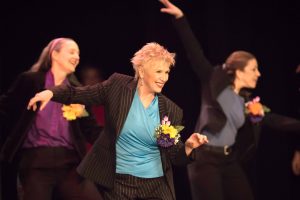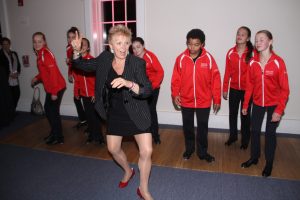Hoofer at Heart

Thelma Goldberg loves the math and the magic of tap.
By Cindy Atoji Keene
A dancer who is an academic might seem like an oxymoron. But that’s only if you haven’t met Thelma Larkin Goldberg, Ph.D., who just received her doctor of philosophy from Lesley University last March. The accomplished tap dancer was defending her dissertation just as the pandemic hit, and while others were cleaning out their offices and rushing to go home, she conferred with her advisor in the barren building. As the state and city shut down, Goldberg never was able to attend a cap and gown ceremony nor the symbolic hooding, but her advanced degree affirmed what everyone who is acquainted with this tousled hair spunky blonde realizes: Goldberg knows her stuff.
Goldberg’s dance studio, the Dance Inn, is a fixture in Lexington, located on the bottom level of the Monroe Center for the Arts on Massachusetts Avenue. With 400-500 students a year, tens of thousands of dancers have waltzed through the Dance Inn classes for over four decades, learning tap, jazz and ballet, hip hop, and adaptive dancing.
But despite her dance business and its numerous productions – recitals, performances, parades, competitions – Goldberg is at heart a tap dancer. Tap dance, rather than just a style of dance, has a complex history with an African American narrative intertwined through its rich origins. While tap dancing today seems to be a lost art featured only in old, grainy black and white movies like Singing in the Rain, Goldberg has centered her life and career around using her body and feet for percussion.
Goldberg would be the first to admit that she doesn’t have a typical petite and diminutive dancer’s body. “I was never raised to see dance as a career,” she said, standing in the living room of her Ledgelawn house. She doesn’t have tap shoes on but demonstrates shuffles and ball changes, brushing lightly against the hardwood floor. “Teachers encouraged me to be excellent in dancing but said, ‘you have to go to college and pursue other things.’” She danced and taught while she earned her degree and was an educator in Boston. But she wanted to take a break, and her husband, Stephen “Goldie” Goldberg, an accountant, agreed that they could open their home, then a small Cape on Hill Street, to students. They moved all the furniture out of their front room, and while the young dancers sang, “I’m a little teapot, short and stout,” Goldie’s tax clients laughed in his adjacent office.
Thus Dance Inn was born, a blur of students, teachers, and recitals. Lexington, said Goldberg, was a perfect place for her studio because the town is clearly dedicated to arts and education. Lexington, as well, is a community of intellectuals and Goldberg’s cerebral approach to dance fits right in. “In order for tap dance to become more relevant in today’s dance world, teaching training programs should be designed to include ‘how’ and why’ to teach tap history and music theory,” she said. Goldberg considers tap-dancing very mathematical, with order and pattern sequences. “I love thinking about rhythm, breaking it down into quarter notes, 16th notes, triplets. Am I swinging or standing? How long can I hold a silence? How many notes fit in a phrase and stay with the choreography or movement I’m trying to express?” Goldberg, who has written two instructional books about tap education, also has an active social media presence, with a YouTube tap dance channel and tap notes blog, and more.
Perhaps the most significant measure of a dance studio’s success is its impact on its students. Countless numbers of Dance Inn trainees have gone onto have their lives changed by dancing. Goldberg’s own children, Sebastian and Robin, are professional dancers. Ryan Casey, a Spanish teacher at Lexington High School, began at the Dance Inn when he was five and went on to become a choreographer, dance journalist, and nationally recognized dancer. “Goldberg puts tap at the forefront of her school, whereas most schools do that with ballet. Putting rhythm-based dancing in the lead is very unconventional,” said Casey.
Goldberg is 68 now, and as tap dancing can be demanding on the back, knees, and feet, she has suffered her share of injuries. Her beloved husband Goldie passed away three years ago from cancer, and she often cries as she dances alone in her living room to songs like Better than Anything by Natalie Cole and Diana Krall. The pandemic has hit the Dance Inn, making it impossible to hold student’s hands while she’s teaching them steps and forcing her to purchase microphones so students can hear instructors through their masks. Portable tap dance floors make it possible to have classes outside, and Zoom sessions have become indispensable.
But does Goldberg have any plans to retire? Absolutely not. Her dance adventures are only just beginning, she says. “I still have too much to do.” Her father, an avid ballroom dancer, didn’t stop dancing till he was 92, and she plans to follow in his footsteps and beyond.
She walks over to her brightly painted stand-up desk, customized for her. Her library – books on tap dancing America; tap dance dictionary; steppin’ blues; vaudeville and jazz bands – perch nearby. Goldberg sees tap dance as having a renaissance lately, with developments and improvisation; she’s having conversations with other experts about the assimilation of tap dance and its musical history, as well as teaching and philosophy. “The integration of music with movement can be an academic experience,” she says. Dancer academian? Hardly an oxymoron when it comes to Goldberg!
1403 Massachusetts Ave, Lexington, MA 02420
Phone: (781) 863-5360



